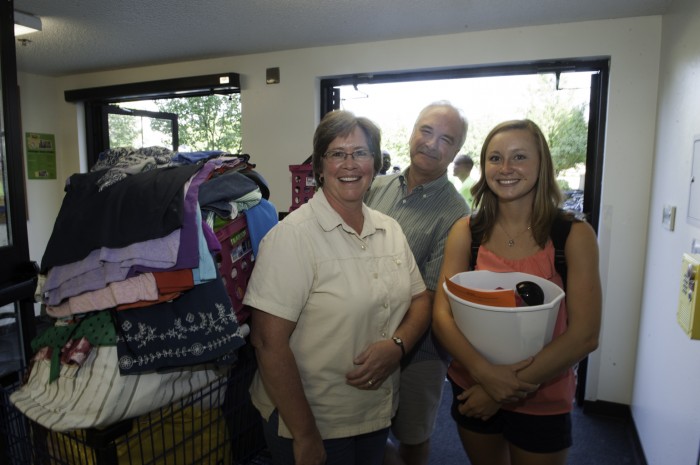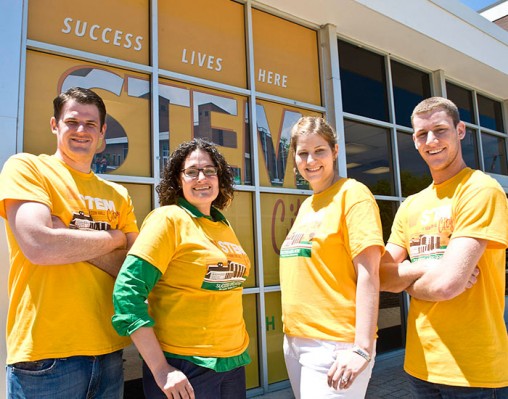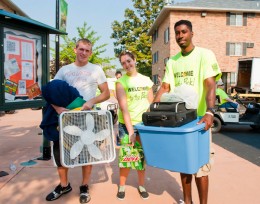
Freshman Molly Hertenstein got a lot of help from her mom and dad during Wright State’s 2014 Move-in Day.
More students are interested in living on campus at Wright State University, with the dorms expected to be nearly full when students arrive for fall semester.
Move-in Day on Wright State’s Dayton Campus began at 9 a.m. Thursday, Aug. 27.
As many as 2,800 students were expected to fill the residence halls and campus apartments, which are built for 3,000. That’s up from 2,400 a year ago and 2,100 two years ago. In addition, more students are returning to the dorms as sophomores.
Dan Bertsos, director of residence life and housing, attributes the increase to the fact that a greater percentage of students have parents and siblings who are familiar with living on campus.
In addition, Bertsos said, the university’s admissions office has made a herculean effort to enroll students and attract many who are interested in the college experience through campus housing.

From left: Jonathan Bullock, graduate student intern; Jennifer Papadakis, STEM City program director; Jennifer Attenweiler, assistant director, Residence Life; Colton Metzger, graduate student intern and STEM City program coordinator.
The dorms have also begun to offer more living-learning communities such as STEM City in Hamilton Hall, where students enrolled in the College of Science and Mathematics and the College of Engineering and Computer Science live and study together.
“Students are responding to that, are interested in that,” said Bertsos.
He said there are many benefits to living on campus.
“Moving to a college campus and living there is life with training wheels,” Bertsos said. “You’ve got resident advisers to help you. You’ve got a lot of students the same age who are going through the same thing. You can all learn responsibility and independence together.”
In addition, said Bertsos, research suggests that students who live on campus more often move on from their freshman year to sophomore year than students who don’t live on campus. They also have better grade point averages and are more likely to graduate on time.

Freshman Robert Lynd was one of many students who were thankful to have the help of volunteers for Move-in Day last year.
Wright State has seven community directors who live in the dorms and supervise the resident advisers. This year, the university has three new community directors — from the University of Wisconsin Oshkosh, Miami University in Ohio and Franklin College in North Carolina, which “brings that very personal connection and mindset of a small private school,” said Bertsos.
“Our objective is to pull people from other campuses with strong housing programs so that we get great ideas from those campuses,” he said.
Fall semester will also usher in a new smartphone safety app for students, faculty and staff, enabling them to call university police at the touch of a button, text officers from their smartphones and have guardians virtually follow them across campus until they safely reach their destination.
Tested over the summer, campus administrators believe the new Raider Guardian safety app will be like putting a blue light phone in the palm of your hand.
One key feature includes a two-push panic button that connects users to Wright State police dispatch. Users can also choose an instant 911 button that calls off-campus 911 dispatch centers. If users would rather send text messages, they can text Wright State police with tips or concerns instead of having to call. Texters can also send images.
Bertsos said he got confirmation that Wright State was doing something right in attracting students to campus housing when he recently fielded an unhappy telephone call from a person complaining there were no spaces left in Hamilton Hall’s STEM City for male students.
“I’ve never had that phone call before,” Bertsos said.

 Wright State psychology team studies ways to identify fatigue in pilots, drivers
Wright State psychology team studies ways to identify fatigue in pilots, drivers  Wright State videographer Kris Sproles wins Regional Emmy and Ohio journalism award
Wright State videographer Kris Sproles wins Regional Emmy and Ohio journalism award  Wright State Boonshoft School of Medicine ranked among the nation’s best for 2024 by U.S. News
Wright State Boonshoft School of Medicine ranked among the nation’s best for 2024 by U.S. News  Exposing biotechnology
Exposing biotechnology  Wright State faculty member Dan Noel uses unique background to inspire new leaders
Wright State faculty member Dan Noel uses unique background to inspire new leaders 